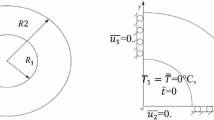Abstract
Generalized thermo-elastic theory, which is based on the non-Fourier theory, indicates that there is a time delay between the heat flux vector and the temperature gradient. At present, the traditional numerical method for solving the thermo-elastic problem subjected to high-frequency heat source generally fails to properly capture discontinuities of impulsive waves in space and produces spurious numerical oscillations in the simulation of high modes and sharp gradients. In the paper, a time discontinuous Galerkin finite element method (DGFEM) for the solution of generalized thermo-elastic coupled problems is presented on the basis of well-known Lord–Shulman theory. The essential feature of the DGFEM is that the general temperature-displacement vector and its temporal gradient are assumed to be discontinuous and interpolated individually at each time level in time domain, respectively. In order to filter out the spurious wave-front oscillations, an artificial damping scheme is implemented in the final finite element formula. Numerical results show that the present DGFEM shows good abilities and provides much more accurate solutions for generalized thermo-elastic coupled behavior. It can capture the discontinuities effectively at the wave front and filter out the effects of spurious numerical oscillation induced by a high-frequency thermal shock.
Similar content being viewed by others
References
Biot M.: Thermoelasticity and irreversible thermo-dynamics. J. Appl. Phys. 27, 240–253 (1956)
Lord H., Shulman Y.: A generalized dynamical theory of thermo-elasticity. J. Mech. Phys. Solids 15, 299–309 (1967)
Green A.E., Lindsay K.E.: Thermoelasticity. J. Elast. 2, 1–7 (1972)
Green A.E., Naghdi P.M.: Thermoelasticity without energy dissipation. J. Elast. 31, 189–208 (1993)
Zamani A., Hetnarski R.B., Eslami M.R.: Second sound in a cracked layer based on Lord–Shulman theory. J. Therm. Stress. 34, 181–200 (2011)
Wang Y.Z., Zhang X.B, Song X.N.: A unified generalized thermoelasticity solution for the transient thermal shock problem. Acta Mech. 223, 735–743 (2012)
Bagri A., Eslami M.R.: Generalized coupled thermoelasticity of disks based on the Lord–Shulman model. J. Therm. Stress. 27, 691–704 (2004)
Kumar R., Devi S.: Thermomechanical deformation in porous generalized thermoelastic body with variable material properties. Struct. Eng. Mech. 34, 285–300 (2010)
Prevost J.H., Tao D.: Finite element analysis of dynamic coupled thermoelasticity problems with relaxation times. J. Appl. Mech. 50, 817–822 (1983)
Hosseini T.P., Eslami M.R.: Boundary element analysis of finite domains under thermal and mechanical shock with the Lord–Shulman theory. J. Strain Anal. Eng. 38, 53–64 (2003)
Tamma K.K., Namburu R.R.: Computational approaches with applications to nonclassical and classical thermo-mechanical problems. Appl. Mech. Rev. 50, 514–551 (1997)
Tamma K.K., Zhou X., Sha D.S.: Transient algorithms for heat transfer: general developments and approaches for theoretically generating Nth-order time-accurate operators including practically useful second-order forms. Int. J. Numer. Method Eng. 44, 1545–1572 (1999)
Tamma, K.K., Zhou, X.,Valasutean, R.: Computational algorithms for transient analysis: the burden of weight and consequences towards formalizing discrete numerically assigned [DNA] algorithmic markers: wp-family. Comput. Meth. Appl. Mech. Eng. 149, 153–188 (1997)
Li X.K., Yao D.M.: Time discontinuous Galerkin finite element method for dynamic analyses in saturated poro-elasto-plastic medium. Acta Mech Sinca 20, 64–75 (2004)
Wu W.H., Li X.K.: Application of the time discontinuous Galerkin finite element method to heat wave simulation. Int. J. Heat Mass Transf. 49, 1679–1684 (2006)
Du X.L., Wang J.T.: An explicit difference formulation of dynamic response calculation of the elastic structure with damping. Eng. Mech. 17, 37–43 (2000)
Izuru T., Mitsuru N.: Stiffness-damping simultaneous identification using limited earthquake records. Earthq. Eng. Struct. Dyn. 29, 1219–1238 (2000)
Strunin D.V., Melnik R.V., Roberts A.J.: Coupled thermo-mechanical waves in hyperbolic thermo-elasticity. J. Therm. Stress. 24, 121–140 (2001)
Author information
Authors and Affiliations
Corresponding author
Rights and permissions
About this article
Cite this article
Guo, P., Wu, WH. & Wu, ZG. A time discontinuous Galerkin finite element method for generalized thermo-elastic wave analysis, considering non-Fourier effects. Acta Mech 225, 299–307 (2014). https://doi.org/10.1007/s00707-013-0961-8
Received:
Revised:
Published:
Issue Date:
DOI: https://doi.org/10.1007/s00707-013-0961-8




